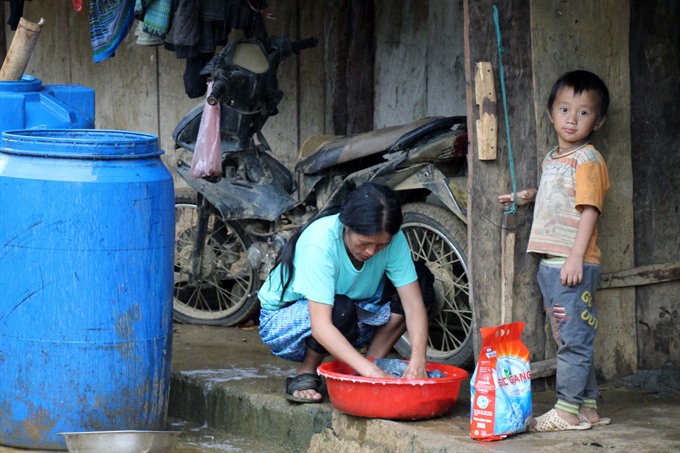 Society
Society

Ethnic minority girls from remote mountainous areas in Sơn La Province are pushing themselves for marriage, despite being underage, in the hope of a better life.
 |
| Hờ Thị Chư, a mother of two children at the age of 18, washes clothes at her cottage in the hillside in northern mountainous Sơn La Province’s Vân Hồ District. — VNA/VNS Photo Diệp Anh |
SƠN LA — Ethnic minority girls from remote mountainous areas in Sơn La Province are pushing themselves for marriage, despite being underage, in the hope of a better life.
Children as young as 13 still believe tying the knot will help them get out of poverty even though getting married so young could lead to a precarious future.
Many marry when they are between 13 and 16 years old even though the Law on Marriage and Family sets the minimum legal age at 18 for women and 20 for men.
As a result, many have ended up carrying the burden of being child brides, including interrupting in schooling, early pregnancy and social isolation. They have found themselves stuck at home, unemployed and poor.
Married before adulthood
Hờ Thị Chư is among such cases. The H’Mông girl was married with a boy at the same village in Vân Hồ District’s Lóng Luông Commune when she was 15. At the age of 18, she is now mother of two children, three years old and six-months old.
Life of post-marriage of the girl is full of difficulties. Chư is living with her parents-in-law in a cottage in the hillside in Co Lóng Village. There is nothing valuable in the cottage. In rainy season, all six members of the family usually stay hungry as there are no jobs available for them at fields.
Chư told a Vietnam News Agency correnpondent that she and her husband were both under the legal age for marriage, so they could not register for marriage certificate.
This means both their children don’t have birth certificates or health insurance cards.
“When they get ill, I take them to a healer in the village to get medicine,” she said.
Giàng Thị Gánh, another girl in Vân Hồ District’s Vân Hồ Commune is luckier. She dropped out of school to get married when she was 17. Her husband, Sồng A Giống, has graduated from high school and earned a living thanks to the family’s tea garden. Gánh is now staying at home, doing household work and taking care of the children.
She said early marriage was a traditional custom of H’Mông people in her village, who believed the ideal ages of a girl to get married were between 13 and 14.
Gánh said she was afraid that the boy would fall in love with another girl if she hesitated to tie the knot with him. Although the school representatives came to persuade her to keep her studying, she insisted on quitting her education to start a family.
Gánh now regrets the decision and says she wanted to go back to school one day.
According to the provincial Department of Population and Family Planning, Sơn La was among the provinces with highest numbers of early marriage in the country. In 2017, as many as 1,500 child marriages took place, accounting for 18.7 per cent of total marriages of the province.
Of that, Vân Hồ District had the highest rate of child marriage, accounting for 27.3 per cent of total child marriages in the province.
Efforts achieved little
The number of early marriages is showing little signs of slowing down, while functional agencies admit their efforts to protect young girls from being child brides have not been successful.
Hà Thị Liên, official who is in charge of population and family planning issues from Vân Hồ District’s Health Preventive Centre, said early marriage was a traditional practice of ethnic minorities as they believed it would help their children stabilise their life and have more people to work.
The number has a tendency to increase due to the shortage of reproductive knowledge of young people, leading to unwanted pregnancy, she said.
Chairman of Vân Hồ Commune’s People’s Committee Ngô Văn Dự said the committee had worked with other neighbouring communes to strengthen education on reproductive healthcare and early marriage to young people in Vân Hồ, Lóng Luông communes in Sơn La Province and Pa Cò and Hang Kia communes in Hòa Bình Province.
The four communes had set up a general convention for local H’Mông people, in which they commit not to conduct child marriage for their children.
However, Dự said, the convention brought no effectiveness as many local people are not aware of the consequences.
Head of the provincial Department of Population and Family Planning Trần Đình Thuận, said early marriage posed a challenge on improving population quality and was a barrier for development in communities.
Thuận said after the project was approved, the province has implemented measures to improve the situation.
After three years of implementation, 12 schools have been built at 35 communes and the model of intervention on early and inter-family marriage has been carried out.
The province hopes to reduce the rate of early and inter-family marriage to 18.5 per cent by 2020.
Thuận said education needs to be boosted in the future. Local authorities need to co-operate with heads or elderly persons of each village to put a stop to backward customs in their communities.
He also suggested that those who were in charge of managing and curbing early marriages take more responsibility.
Fines for violators needed to be increased, he said, adding that the current fines were not strict enough. — VNS




